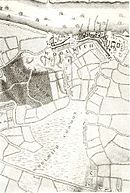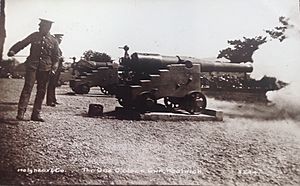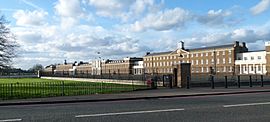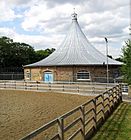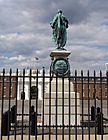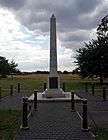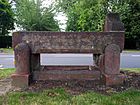Woolwich Common facts for kids
Quick facts for kids Woolwich Common |
|
|---|---|
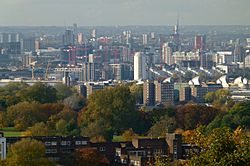
View of Woolwich Common (from Shooter's Hill)
|
|
| Type | common land, urban park |
| Location | Woolwich, London |
| Area | 60 hectares (150 acres) |
| Status | military terrain (partly); conservation area |
| Public transit access | Woolwich Arsenal station |
Woolwich Common is a large open space in Woolwich, southeast London, England. It's a type of land called a "common," which means it was traditionally used by local people for things like grazing animals. Today, part of it is still used by the military, and another part is a public urban park. It's also a special "conservation area," meaning it's protected for its natural beauty and history. Woolwich Common is part of the South East London Green Chain, a network of green spaces. The name "Woolwich Common" also refers to a street nearby and a local election area.
Contents
Where is Woolwich Common?
Woolwich Common sits on the northern side of Shooter's Hill. This hill is 132 metres high and is in the Royal Borough of Greenwich. The common is just a short distance southwest of Woolwich town centre.
To the south, it's bordered by Shooters Hill Road (A207). Even further south, you'll find more green spaces like Oxleas Wood and Eltham Common. Academy Road and the old Royal Military Academy are on the eastern side. Repository Road and the Queen Elizabeth Hospital form the western edge. On the north, Ha-ha Road separates the military part of the common from the public park area.
The History of Woolwich Common
Long ago, before the mid-1700s, Woolwich Common was much bigger. It stretched across a large part of Shooter's Hill. People used the common for grazing their cattle and sheep. They also collected peat, wood, and gorse (a spiky plant) for fuel.
The land belonged to the Crown (the King or Queen). It was different from most of Woolwich, which was owned by a family called Bowater.
Changes to the Common
As the Woolwich Dockyard and Royal Arsenal grew, local people worried about losing their traditional rights to use the common. When some parts of the common were sold for building houses in the 1700s, the local council fought to protect their rights. They managed to stop more houses from being built.
By the 1720s, the Board of Ordnance (a government group in charge of military supplies) started using the common. They tested mortars there. Later, they set up a firing range for artillery practice. Even with military use, people still grazed animals and dug for gravel to build roads.
A big change happened between 1774 and 1776. The Royal Artillery Barracks were built north of the common. A part of the common was used for a parade ground, now called Barrack Field. A special ditch called a ha-ha was built to separate the barracks from the common.
By the late 1700s, the common was used for large military parades and training. The Royal Military Academy was built on the common's southeast side between 1796 and 1805. This was the first major military building on the common itself.
In 1803, the Board of Ordnance bought the common from its owner. They also bought Charlton Common nearby. After this, the land was mostly cleared for military use. This caused arguments between locals and the military for over a hundred years. Locals felt they still had rights to the land, while the military claimed full ownership.
The Common Under Military Control
Artillery Training
In 1803, the military built a mortar battery on Green Hill, west of the barracks. They used it for artillery training, firing south across the common. This meant removing a large hedge. Mortar practice stopped around 1873, but the battery was still used for saluting (firing guns to honor someone) into the 1900s.
Horses and Army Vets
From early on, the common was used to train and exercise military horses, including those from the Royal Horse Artillery. By 1804, a "Veterinary Establishment" (an animal hospital) was built. It grew into the Royal Horse Infirmary. This became the main place for the Army Veterinary Department when it started in 1859.
Later, in the 1850s, a camp of huts was built for soldiers. In 1896, Shrapnel Barracks was built nearby for artillery units. This barracks was used for soldiers and horses through both World Wars. It was knocked down in the late 1960s, and the Queen Elizabeth Hospital now stands there.
A Remount Depot (a place to get and train new horses for the army) was built in 1887. After problems in the Second Boer War, the army improved its animal care. In 1903, a new army veterinary hospital was set up at Woolwich. This became the main base for the new Army Veterinary Corps (RAVC). The RAVC depot stayed at Woolwich until 1939.
Houses and Hospitals
In the 1730s, there were only a few small houses along the east side of the common. But from the 1780s, large houses for military officers began to appear. One of the biggest, Cube House, was built in 1792. The Crown later bought this land. Cube House became a hospital for cadets (students) at the Royal Military Academy.
Other grand houses were built, like Belmont Place and Clarence Place. Famous people lived here, including General Gordon, who was born at 29 Woolwich Common in 1833. Sadly, most of these historic houses were pulled down between 1972 and 1975 to build new social housing (the Woolwich Common Estate).
On the western side, married soldiers built simple "mud huts" for their families in the early 1800s. These were replaced in 1812 with new cottages, but they were later demolished in the 1870s after a disease outbreak.
Over the 1800s and 1900s, many military and civilian hospitals were built near the common. These included the Royal Herbert Hospital (1865), Brook Fever Hospital (1896), and the Woolwich and District War Memorial Hospital (1927). The Queen Elizabeth Military Hospital was built in 1977 where Shrapnel Barracks used to be. It closed in 1995 but reopened as a civilian hospital in 2006.
Big Events
Woolwich Common had plenty of space for large military events. In 1788, King George III asked for a parade there. King William IV inspected thousands of troops in 1830 and 1835. Many other royal visits and military shows happened through the years.
In 1919, a big outdoor service was held on the common to celebrate the end of World War I. The next year, 50,000 people came for a memorial service. Later, the Royal Artillery held "At Home" events for the public. These stopped in the 1970s because of safety concerns.
Historic Buildings on the North Side
The Royal Artillery Barracks is a huge building with a long, grand front (façade) that stretches along the north end of the common. It was designed by James Wyatt and built between 1776 and 1802. It has the longest building front in London!
Across the road is Government House (1781). This was where the military commander of the area lived for many years. It's the only grand old house left overlooking the common.
The Garrison Church of St George was badly damaged in 1944 during a bombing raid. Only its outer walls remain, but you can still see its impressive design and parts of its mosaics.
On the northwest side, you'll find Green Hill Barracks and the Rotunda. The Rotunda is a round brick building with a tent-like roof. It was designed by John Nash. It started as a display space in St. James's Park in 1814. It was moved to Woolwich between 1819 and 1822 to show off military trophies and models. Until 2001, it housed the Royal Artillery Museum. Now, it's used as a boxing ring for the King's Troop, Royal Horse Artillery.
Historic Buildings on the South Side
The Royal Military Academy is at the south end of Woolwich Common. It's like a mirror to the Royal Artillery Barracks at the north end. It also has a very long front, built in a style called Mock Tudor. The oldest parts were also designed by James Wyatt.
Other military buildings that are still standing on this side of the common include the Royal Herbert Hospital and Victoria House. Both are on Shooters Hill. All three of these historic buildings have been, or are being, turned into homes.
Monuments and Memorials
On the south end of the Royal Artillery Barracks parade ground is the Crimean War Memorial. It was made by John Bell in 1861. The bronze statue of a woman giving out laurel wreaths was made entirely from Russian cannons captured during the war.
On the east side of the common, along Woolwich New Road, you'll see two memorials shaped like obelisks (tall, thin pillars). The Major Little Memorial, which was originally a drinking fountain, is from 1863. Next to it is a 19th-century drinking fountain for horses. The Second Boer War Memorial dates from around 1902.
Along Repository Road, you can see several old cannons on display. Some were moved when the Royal Artillery left Woolwich in 2007.


